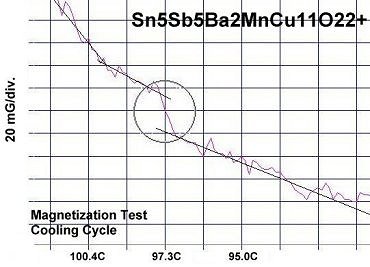
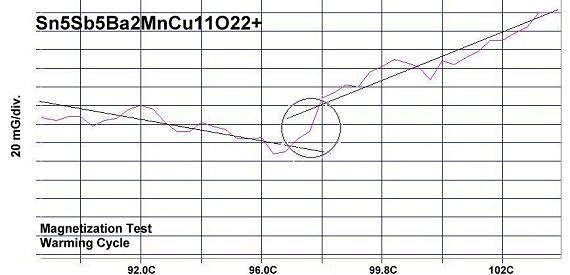


Superconductors.ORG herein reports the discovery of a new material that exhibits record superconductivity above 95 Celsius (203F, 368K). Its chemical formula is Sn5Sb5Ba2MnCu11O22+. This copper-oxide ceramic stands out among the 20 room-temperature superconductors discovered so far. Being non-toxic and non-brittle, it is RoHS compliant as well as more durable than previous formulations.
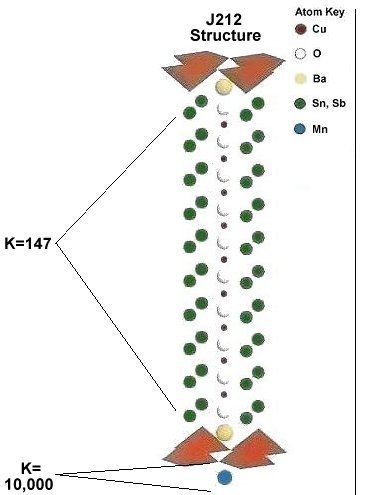
|
The two plots at page top clearly show a Meissner transition above 95C that appeared in more than a dozen magnetization tests of this material.1 The target J212 structure, like previous room-temperature discoveries, does not want to form naturally (see graphic at left). This results in a very low volume fraction of the desired phase. Nonetheless, a diamagnetic transition in the range of 30-40 milli-Gauss is visible above the noise floor in both plots. The straight lines represent the average of the data points, skewing apart at Tc, the critical transition temperature. With the discovery of 77C and 65C superconductors in early 2014, the importance of dielectric constant (K) in the X212 structure anion was confirmed. As such, in this latest discovery the molecule was specifically designed to have a high K in both the anion and cation layers. Adjacent tin (Sn) and antimony (Sb) atoms in the cation chain have a nominal K of 147. Coupled with a K of 10,000 in the MnO2 anion layer, nearly the entire unit cell functions as a charge reservoir.2 In most of the previous room-temperature formulations, thallium was used along with a hole-dopant like lead, tin or barium to achieve a high planar weight ratio (PWR) along the C1 axis. Since 2005 planar weight disparity has been found to be an essential component of high-temperature superconductivity. So switching to the lighter combination of tin and antimony lowers the PWR, but raises the K. Specifically: the 77C superconductor had a PWR of 13.1 along the C1 axis, while the 95C material has a PWR of 9.5. This confirms that dielectric constant is even more influential than PWR in promoting Tc. |
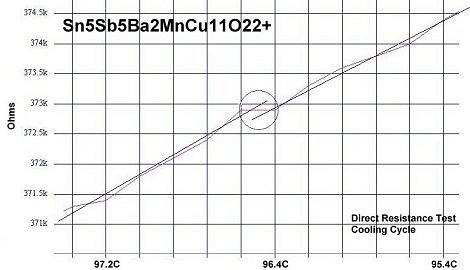
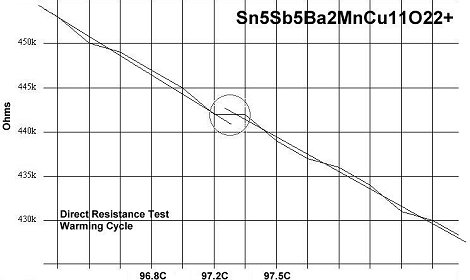
The above direct resistance plots confirm that superconductivity is the mechanism at work in this discovery. As such, the scientific community needs to stop pretending room temperature superconductivity has not yet been achieved. In the physical sciences there is no phenomenon other than superconductivity that can explain a sharp diamagnetic transition and a resistance drop at the same temperature.
Note that the bulk has a negative temperature coefficient, sloping the opposite direction as the superconductive transitions. All of the plots on this page exhibit a low signal-to-noise ratio due to a low volume fraction of superconductive material and a high thermal noise level inherent to these temperatures.
In order to maximize formation of the J212 structure3, this compound was synthesized using the layer cake method, as shown below. The pellet had approximately 100 interference layers. And, even using this layering technique, the volume fraction is low, requiring very sensitive test equipment.
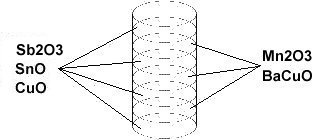
Stoichiometric ratios of the below chemicals were used for the ODD layers:
SnO 99.9% (Alfa Aesar) 4.88 grains...and the below ratios for the EVEN layers.
Mn2O3 98% (Alfa Aesar) 0.57 grainThe chemical precursors were pelletized at 60,000 PSI and sintered for 34 hours at 860C. The pellet was then annealed for 10+ hours at 500C in flowing O2. Temperature was determined using an Omega type "T" thermocouple and precision OP77 DC amplifier. The magnetometer employed twin Honeywell SS94A1F Hall-effect sensors with a tandem sensitivity of 50 mv/Gauss.
RESEARCH NOTE: The copper-oxides are strongly hygroscopic. All tests should be performed immediately after annealing.
RE-PUBLICATION NOTICE: Elsevier Publishing, dba Elsevier Science, as well as Morris Communications, both print and broadcast divisions, are specifically prohibited from re-publishing any part of this news story.
E. Joe Eck
© 2014 Superconductors.ORG
All rights reserved.
1. Testing temperatures are believed accurate within ± 0.5 degrees C. [rapid prototyping]
2. Dielectric constants were obtain from H. P. R. Frederikse, CRC Handbook of Chemistry and Physics.
3. The "J" in J212 is a vigesimal representation of decimal 19.
 BACK to "News" page at Superconductors.ORG
BACK to "News" page at Superconductors.ORG